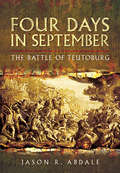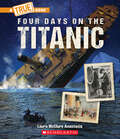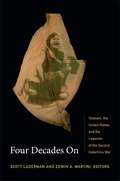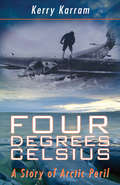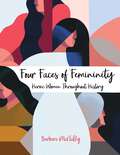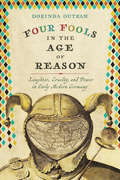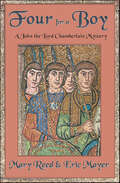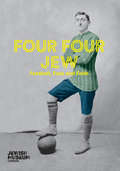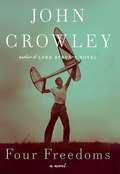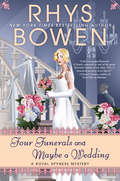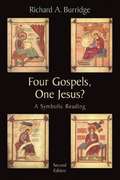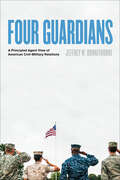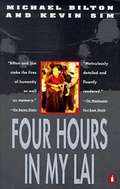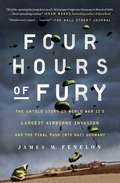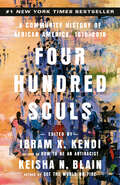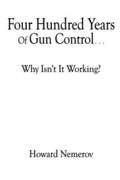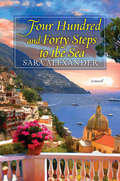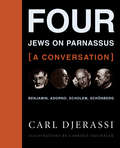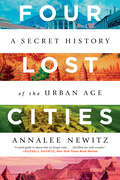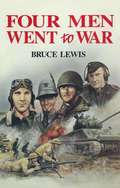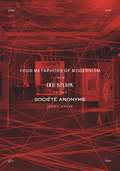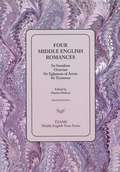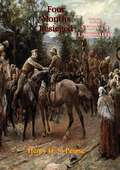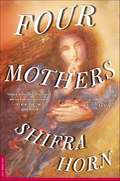- Table View
- List View
Four Days in September: The Battle of Teutoburg
by Jason R. AbdaleThe author of The Great Illyrian Revolt examines one of the Roman Empire's most pivotal defeats—a surprise attack by Germanic barbarians in 9 AD. For twenty years, the Roman Empire conquered its way through modern-day Germany, claiming all lands from the Rhine to the Elbe. However, when at last all appeared to be under control, a catastrophe erupted that claimed the lives of 10,000 legionnaires and laid Rome's imperial ambitions for Germania into the dust. In late September of 9 AD, three Roman legions, while marching to suppress a distant tribal rebellion, were attacked in a four-day battle with the Germanic barbarians. The Romans under the leadership of the province's governor, Publius Quinctilius Varus, were taken completely by surprise, betrayed by a member of their own ranks: the German officer and secret rebel leader, Arminius. The defeat was a heavy blow to both Rome's military and its pride. Though the disaster was ruthlessly avenged soon afterwards, later attempts at conquering the Germans were half-hearted at best.Four Days in September thoroughly examines the ancient sources and challenges the hypotheses of modern scholars to present a clear picture of the prelude to the battle, the fighting itself and its aftermath.
Four Days on The Titanic (A True Book (Relaunch))
by Laura McClure AnastasiaRediscover the story of the largest and most luxurious ship ever built!For the first four days, everything went as planned on the Titanic. First-class passengers enjoyed their large, beautifully furnished rooms and 10-course meals in the ship's fanciest dining room. They also enjoyed using the reading rooms, the huge swimming pool, and the gymnasium. Second- and third-class passengers sailed in their not quite so fancy facilities. Then, on the evening of April 14, just one day short of arriving in New York, the Titanic struck an iceberg. 2 hours and 40 minutes later, the "unsinkable" ship disappeared beneath the waves. More than 1,500 of the 2,200 people on board perished. It was the biggest maritime tragedy to date. Four Days on the Titanic offers a firsthand look at life, and tragedy, on this mighty vessel.ABOUT THIS SERIES: On the night of April 14-15, 1912, the largest and most luxurious ship ever built hit an iceberg and sunk on her maiden voyage. More than 100 years later, the Titanic continues to fascinate. How did this supposedly "unsinkable" ship meet its icy fate? Who were the people who sailed on the ship, and what was that experience like before, during, and after the disaster? What did explorers discover in 1985 when they found the sunken ship at the bottom of the Atlantic Ocean? Featuring historical imagery, first-hand accounts, and lively text, the four titles in this series will answer all these questions… and more.
Four Decades On: Vietnam, the United States, and the Legacies of the Second Indochina War
by Scott Laderman Martini Edwin A.In Four Decades On, historians, anthropologists, and literary critics examine the legacies of the Second Indochina War, or what most Americans call the Vietnam War, nearly forty years after the United States finally left Vietnam. They address matters such as the daunting tasks facing the Vietnamese at the war's end--including rebuilding a nation and consolidating a socialist revolution while fending off China and the Khmer Rouge--and "the Vietnam syndrome," the cynical, frustrated, and pessimistic sense that colored America's views of the rest of the world after its humiliating defeat in Vietnam. The contributors provide unexpected perspectives on Agent Orange, the POW/MIA controversies, the commercial trade relationship between the United States and Vietnam, and representations of the war and its aftermath produced by artists, particularly writers. They show how the war has continued to affect not only international relations but also the everyday lives of millions of people around the world. Most of the contributors take up matters in the United States, Vietnam, or both nations, while several utilize transnational analytic frameworks, recognizing that the war's legacies shape and are shaped by dynamics that transcend the two countries. Contributors. Alex Bloom, Diane Niblack Fox, H. Bruce Franklin, Walter Hixson, Heonik Kwon, Scott Laderman, Mariam B. Lam, Ngo Vinh Long, Edwin A. Martini, Viet Thanh Nguyen, Christina Schwenkel, Charles Waugh
Four Degrees Celsius: A Story of Arctic Peril
by Kerry KarramA dramatic story of the rescue of eight men on a prospecting mission in the Arctic that covers a period of four suspenseful months in the fall of 1929. This true story began in August 1929. A group of eight prospectors, led by C.D.H. MacAlpine of the Dominion Explorers, flew into the Arctic in search of mineral wealth. Grossly underequipped, the expedition ran out of fuel and was stranded above the Arctic Circle. Within days, Western Canada Airways sent a rescue team headed by Captain Andy Cruickshank, in what was to become the most extensive aviation search in Canadian history.The searchers encountered trouble: turbulent weather, forced landings, and plane crashes. The prospectors were also struggling, as they waited edgily for freeze-up and the anticipated crossing to Cambridge Bay. While Cruickshank and his team were trying to reconstruct a damaged aircraft, MacAlpine and his men were forced to run more than 112 kilometres on barely frozen ice to arrive at Cambridge Bay, where they still awaited rescue.
Four Dubliners: Wilde, Yeats, Joyce, and Beckett
by Richard EllmannBiographies, histories, and literary criticisms of the 4 Irish authors.
Four Faces of Femininity: Heroic Women Throughout History
by Barbara McNallyFour Faces of Femininity tells the story of remarkable women who, through their creativity, passion, intelligence, and sheer determination, have left an indelible mark on the history of humankind. The book is divided into four sections, with figures placed in Mother, Lover, Warrior, or Sage. Accessible, informative, and uplifting, Four Faces of Femininity explores the many ways in which women have changed the course of history—and demonstrates how crucial it is that women from every background be provided with role models that inspire. The book includes questions for exploration to help modern multifaceted women see these qualities in themselves and balance them to lead a fuller life.
Four Fools in the Age of Reason: Laughter, Cruelty, and Power in Early Modern Germany (Studies in Early Modern German History)
by Dorinda OutramUnveiling the nearly lost world of the court fools of eighteenth-century Germany, Dorinda Outram shows that laughter was an essential instrument of power. Whether jovial or cruel, mirth altered social and political relations. Outram takes us first to the court of Frederick William I of Prussia, who emerges not only as an administrative reformer and notorious militarist but also as a "master of fools," a ruler who used fools to prop up his uncertain power. The autobiography of the itinerant fool Peter Prosch affords a rare insider’s view of the small courts in Catholic south Germany, Austria, and Bavaria. Full of sharp observations of prelates and princes, the autobiography also records episodes of the extraordinary cruelty for which the German princely courts were notorious. Joseph Fröhlich, court fool in Dresden, presents more appealing facets of foolery. A sharp salesman and hero of the Meissen factories, he was deeply attached to the folk life of fooling. The book ends by tying the growth of Enlightenment skepticism to the demise of court foolery around 1800.Outram’s book is invaluable for giving us such a vivid depiction of the court fool and especially for revealing how this figure can shed new light on the wielding of power in Enlightenment Europe.
Four For A Boy (John, the Lord Chamberlain Mysteries #4)
by Mary Reed Eric MayerNominee, Bruce Alexander History Mystery AwardBest Little Known Series, BooklistIt's unnaturally cold in Constantinople this winter of 525. The Emperor Justin is dying, and Theodora, the ambitious former actress his gravely ill successor Justinian intends to marry, is making demands in the imperial court.When a wealthy philanthropist is killed in broad daylight in the Great Church, it isn't entirely surprising that Justinian engages an anonymous young slave called John to investigate what many believe could be a conspiracy aimed at swaying the succession. Suspects are many among those whose lives might be touched by an emperor: senators, churchmen, wealthy businessmen, even laborers, beggars, and prostitutes.In this prequel to the series, John takes his first dangerous steps along the path toward freedom from slavery and his eventual appointment as Lord Chamberlain.
Four Four Jew
by Joanne RosenthalFour Four Jew is a major exhibition by Jewish Museum London exploring the story of football and Jews in Britain from the turn of the century to the present day. It brings together previously unseen material from private and public collections across the UK to tell the story of the clubs, the players, the Chairmen, the fans, and the 'religion' that is the beautiful game. This publication to accompany the exhibition features illustrated highlights together with newly commissioned articles by leading writers and historians.
Four Freedoms
by John CrowleyOne of the most admired and honored of our contemporary literary artists, author John Crowley now brilliantly re-creates a time in America when ordinary people were asked to sacrifice their comforts and uproot their lives for the cause of freedom. In the early years of the 1940s, as the nation's young men ship off to war, the call goes out for builders of the machinery necessary to defeat the enemy. To this purpose, a city has sprung up seemingly overnight in the windswept fields of Oklahoma: the Van Damme airplane factory, a gargantuan complex dedicated to the construction of the B-30 Pax, the largest bomber ever built. Laborers--some men, but mostly women, many of whom have never operated a rivet gun or held a screwdriver--flock to this place, eager to earn, to grow, to do their part. Many are away from home for the very first time, enticed by the opportunity to be something more than wife and homemaker. In the middle of nowhere they will live, work, and earn their own money, fearing for the safety of their absent fighting men as the world around them changes forever. Vi, with her gun of a pitching arm, finds Van Damme after fleeing a dying ranch and a stubborn, broken father to chase a future built on something stronger than poison earth. Connie, once fragile and helpless, follows an unfaithful husband here with their little boy in tow--and inadvertently discovers who she is and what she's capable of achieving. Before Diane can enter the factory's gates, the restless young woman must leave behind the hot music and soldier boys she followed, taking a sudden, bold, and dangerous step in pursuit of something different, adult, and real. Their journeys will be liberating in ways they couldn't imagine, and will lead each of them to Prosper Olander. Disabled, an artist, a forger, a friend--a surprising lover and compassionate listener--Prosper has followed unlikely opportunity down a painfully twisting path to take his place as the true heart and soul of a temporary city. And before the B-30 Pax takes flight, he will change the lives of four women in profound and unexpected ways. Destined to stand tall among his previous acclaimed fiction--including Little, Big; The Ægypt Cycle; The Translator; and Lord Byron's Novel--John Crowley's Four Freedoms is perhaps his most heartfelt and compelling novel to date. It is a moving, evocative, and unforgettable saga of wives, mothers, and lovers--of strangers, outcasts, and damaged Quixotes--who, unmoored by conflict's unpredictable tides, find community, purpose, identity, independence . . . and one remarkable man who will touch them all.
Four Funerals and Maybe a Wedding (A Royal Spyness Mystery #12)
by Rhys BowenIn the days leading up to her wedding to Darcy O'Mara, Lady Georgiana Rannoch takes on the responsibilities of a grand estate, but proving she can run a household just may be the death of her in the new Royal Spyness Mystery from the New York Times bestselling author of On Her Majesty's Frightfully Secret Service.If only Darcy and I had eloped! What I thought would be a simple wedding has been transformed into a grand affair, thanks to the attendance of the queen, who has offered up the princesses as bridesmaids. Silly me! I thought that withdrawing from the royal line of succession would simplify my life. But before Darcy and I tie the knot in front of queen and country, we have to find a place to live as man and wife...House hunting turns out to be a pretty grim affair. Just as we start to lose hope, my globetrotting godfather offers us his fully staffed country estate. Mistress of Eynsleigh I shall be! With Darcy off in parts unknown, I head to Eynsleigh alone, only to have my hopes dashed. The grounds are in disarray and the small staff is suspiciously incompetent. Not to mention the gas tap leak in my bedroom, which I can only imagine was an attempt on my life. Something rotten is afoot--and bringing the place up to snuff may put me six feet under before I even get a chance to walk down the aisle...
Four Gospels, One Jesus
by Richard A. BurridgeIn this very readable book Richard Burridge depicts Jesus through the four Gospel authors' distinctive portraits of him. Without bogging down readers with technical terminology, Burridge brings to bear his research comparing the Gospels with classical biographies and offers a clear interpretation of each Gospel author's portrait. In a particularly striking move, he draws on the traditional symbols of the Gospels - the human face, lion, ox, and eagle - to represent each book's unique picture of Jesus.
Four Guardians: A Principled Agent View of American Civil-Military Relations
by Jeffrey W. DonnithorneExploring the profound differences between what the military services believe—and how they uniquely serve the nation.When the US military confronts pressing security challenges, the Army, Navy, Air Force, and Marine Corps often react differently as they advise and execute civilian defense policies. Conventional wisdom holds that these dynamics tend to reflect a competition for prestige, influence, and dollars. Such interservice rivalries, however, are only a fraction of the real story. In Four Guardians, Jeffrey W. Donnithorne argues that the services act instead as principled agents, interpreting policies in ways that reflect their unique cultures and patterns of belief. Chapter-length portraits of each service highlight the influence of operational environment ("nature") and political history ("nurture") in shaping each service's cultural worldview. The book also offers two important case studies of civil-military policymaking: one, the little-known story of the creation of the Rapid Deployment Joint Task Force in the early 1980s; the other, the four-year political battle that led to the passage of the Goldwater-Nichols Act in 1986. Donnithorne uses these cases to demonstrate the principled agent framework in action while amply revealing the four services as distinctly different political actors. Combining crisp insight and empirical depth with engaging military history, Four Guardians provides practical utility for civil-military scholars, national security practitioners, and interested citizens alike. This timely work brings a new appreciation for the American military, the complex dynamics of civilian control, and the principled ways in which the four guardian services defend their nation.
Four Hours in My Lai
by Kevin Sim Michael BiltonUncovering the secrets behind the 1968 My Lai massacre in Vietnam, this is "a brutal, cautionary tale that serves as a painful reminder of the worst that can happen in war. "--Chicago Tribune.
Four Hours of Fury: The Untold Story of World War II's Largest Airborne Invasion and the Final Push into Nazi Germany
by James M. Fenelon&“Compellingly chronicles one of the least studied great episodes of World War II with power and authority…A riveting read&” (Donald L. Miller, New York Times bestselling author of Masters of the Air) about World War II&’s largest airborne operation—one that dropped 17,000 Allied paratroopers deep into the heart of Nazi Germany.On the morning of March 24, 1945, more than two thousand Allied aircraft droned through a cloudless sky toward Germany. Escorted by swarms of darting fighters, the armada of transport planes carried 17,000 troops to be dropped, via parachute and glider, on the far banks of the Rhine River. Four hours later, after what was the war&’s largest airdrop, all major objectives had been seized. The invasion smashed Germany&’s last line of defense and gutted Hitler&’s war machine; the war in Europe ended less than two months later. Four Hours of Fury follows the 17th Airborne Division as they prepare for Operation Varsity, a campaign that would rival Normandy in scale and become one of the most successful and important of the war. Even as the Third Reich began to implode, it was vital for Allied troops to have direct access into Germany to guarantee victory—the 17th Airborne secured that bridgehead over the River Rhine. And yet their story has until now been relegated to history&’s footnotes. In this viscerally exciting account, paratrooper-turned-historian James Fenelon &“details every aspect of the American 17th Airborne Division&’s role in Operation Varsity...inspired&” (The Wall Street Journal). Reminiscent of A Bridge Too Far and Masters of the Air, Four Hours of Fury does for the 17th Airborne what Band of Brothers did for the 101st. It is a captivating, action-packed tale of heroism and triumph spotlighting one of World War II&’s most under-chronicled and dangerous operations.
Four Hundred Souls: A Community History of African America, 1619-2019
by Ibram X. Kendi Keisha N. BlainA chorus of extraordinary voices comes together to tell one of history’s great epics: the four-hundred-year journey of African Americans from 1619 to the present—edited by Ibram X. Kendi, author of How to Be an Antiracist, and Keisha N. Blain, author of Set the World on Fire. <P><P>The story begins in 1619—a year before the Mayflower—when the White Lion disgorges “some 20-and-odd Negroes” onto the shores of Virginia, inaugurating the African presence in what would become the United States. It takes us to the present, when African Americans, descendants of those on the White Lion and a thousand other routes to this country, continue a journey defined by inhuman oppression, visionary struggles, stunning achievements, and millions of ordinary lives passing through extraordinary history. Four Hundred Souls is a unique one-volume “community” history of African Americans. <P>The editors, Ibram X. Kendi and Keisha N. Blain, have assembled ninety brilliant writers, each of whom takes on a five-year period of that four-hundred-year span. The writers explore their periods through a variety of techniques: historical essays, short stories, personal vignettes, and fiery polemics. They approach history from various perspectives: through the eyes of towering historical icons or the untold stories of ordinary people; through places, laws, and objects. While themes of resistance and struggle, of hope and reinvention, course through the book, this collection of diverse pieces from ninety different minds, reflecting ninety different perspectives, fundamentally deconstructs the idea that Africans in America are a monolith—instead it unlocks the startling range of experiences and ideas that have always existed within the community of Blackness. This is a history that illuminates our past and gives us new ways of thinking about our future, written by the most vital and essential voices of our present. <P><P><b>A New York Times Bestseller</b>
Four Hundred Years of Gun Control: Why Isn't It Working?
by Howard NemerovThe subject of gun control for many seems to be a modern issue, but it has been with America since before the nation's inception. Has gun control best served the people or its architects? Investigative analyst Howard Nemerov compares the rhetoric and the legislation to the reality of how gun control's promises and laws have come to affect real people. Nemerov documents the pattern and practice as it has operated throughout the entire life of the nation to date. Today, the observation is that gun control has not worked...Or has it, and for whom? Otherwise, after four hundred years: Why isn't it working?
Four Hundred and Forty Steps to the Sea
by Sara AlexanderIn a richly romantic novel set in stunning Positano, Italy, Sara Alexander weaves a story of love, family loyalty, and sacrifice spanning five decades . . . Nestled into the cliffs in southern Italy’s Amalfi coast, Positano is an artist’s vision, with rows of brightly hued houses perched above the sea and picturesque staircases meandering up and down the hillside. Santina, still a striking woman despite old age and the illness that saps her last strength, is spending her final days at her home, Villa San Vito. The magnificent eighteenth-century palazzo is very different from the tiny house in which she grew up. And as she decides its fate, she must confront the choices that led her here so long ago . . . In 1949, Positano is as yet undiscovered by tourists, a beautiful, secluded village shaking off the dust of war. Hoping to escape poverty, young Santina takes domestic work in London, ultimately becoming a housekeeper to a distinguished British major and his creative, impulsive wife, Adeline. When they move to Positano, Santina returns with them, raising their daughter as Adeline’s mental health declines. With each passing year, Santina becomes more deeply enmeshed within the family, trying to navigate her complicated feelings for a man who is much more than an employer—while hiding secrets that could shatter the only home she knows . . . Praise for Sara Alexander’s Under a Sardinian Sky “Alexander paints a loving and breathtaking picture of the Mediterranean island, especially glorious descriptions of food. For readers who enjoy women’s fiction set against a background of momentous events and clashing cultures.” —Library Journal “Will leave readers riveted until the explosive conclusion.”—Publishers Weekly
Four Jews on Parnassus--A Conversation: Benjamin, Adorno, Scholem, Schönberg
by Carl DjerassiTheodor W. Adorno was the prototypical German Jewish non-Jew, Walter Benjamin vacillated between German Jew and Jewish German, Gershom Scholem was a committed Zionist, and Arnold Schönberg converted to Protestantism for professional reasons but later returned to Judaism. Carl Djerassi, himself a refugee from Hitler's Austria, dramatizes a dialogue between these four men in which they discuss fraternity, religious identity, and legacy as well as reveal aspects of their lives--notably their relations with their wives--that many have ignored, underemphasized, or misrepresented. The desire for canonization and the process by which it is obtained are the underlying themes of this dialogue, with emphasis on Paul Klee's Angelus Novus (1920), a canonized work that resonated deeply with Benjamin, Adorno, and Scholem (and for which Djerassi and Gabrielle Seethaler present a revisionist and richly illustrated interpretation). Basing his dialogue on extensive archival research and interviews, Djerassi concludes with a daring speculation on the putative contents of Benjamin's famous briefcase, which disappeared upon his suicide.
Four Lost Cities: A Secret History Of The Urban Age
by Annalee NewitzA quest to explore some of the most spectacular ancient cities in human history—and figure out why people abandoned them. In Four Lost Cities, acclaimed science journalist Annalee Newitz takes readers on an entertaining and mind-bending adventure into the deep history of urban life. Investigating across the centuries and around the world, Newitz explores the rise and fall of four ancient cities, each the center of a sophisticated civilization: the Neolithic site of Çatalhöyük in Central Turkey, the Roman vacation town of Pompeii on Italy’s southern coast, the medieval megacity of Angkor in Cambodia, and the indigenous metropolis Cahokia, which stood beside the Mississippi River where East St. Louis is today. Newitz travels to all four sites and investigates the cutting-edge research in archaeology, revealing the mix of environmental changes and political turmoil that doomed these ancient settlements. Tracing the early development of urban planning, Newitz also introduces us to the often anonymous workers—slaves, women, immigrants, and manual laborers—who built these cities and created monuments that lasted millennia. Four Lost Cities is a journey into the forgotten past, but, foreseeing a future in which the majority of people on Earth will be living in cities, it may also reveal something of our own fate.
Four Men Went to War
by Bruce LewisThis book tells of the adventures of four men of different nationalities who found themselves caught up in the maelstrom of the Second World War.
Four Metaphors of Modernism: From Der Sturm to the Société Anonyme
by Jenny AngerExploring the significance of metaphor in modern art &“Where do the roots of art lie?&” asked Der Sturm founder Herwarth Walden. &“In the people? Behind the mountains? Behind the planets. He who has eyes to hear, feels.&” Walden&’s Der Sturm—the journal, gallery, performance venue, press, theater, bookstore, and art school in Berlin (1910–1932)—has never before been the subject of a book-length study in English. Four Metaphors of Modernism positions Der Sturm at the center of the avant-garde and as an integral part of Euro-American modern art, theory, and practice.Jenny Anger traces Walden&’s aesthetic and intellectual roots to Franz Liszt and Friedrich Nietzsche—forebears who led him to embrace a literal and figurative mixing of the arts. She then places Der Sturm in conversation with New York&’s Société Anonyme (1920–1950), an American avant-garde group modeled on Der Sturm and founded by Katherine Sophie Dreier, Marcel Duchamp, and Man Ray. Working against the tendency to examine artworks and artist groups in isolation, Anger underscores the significance of both organizations to the development and circulation of international modernism. Focusing on the recurring metaphors of piano, glass, water, and home, Four Metaphors of Modernism interweaves a historical analysis of these two prominent organizations with an aesthetic analysis of the metaphors that shaped their practices, reconceiving modernism itself. Presented here is a modernism that is embodied, gendered, multisensory, and deeply committed to metaphor and a restoration of abstraction&’s connection with the real.
Four Middle English Romances: Sir Isumbras, Octavian, Sir Eglamour Of Artois, Sir Tryamour (Teams Middle English Texts Series)
by Harriet HudsonSir Isumbras, Octavian, Sir Eglamour of Artois, and Sir Tryamour are important works in a major literary development of the fourteenth century: the flourishing of Middle English popular romance. <P><P> These four narratives were among the most popular; all survive in multiple manuscripts and continued to circulate in prints through the sixteenth century. All were composed in the northeast Midlands in the fifty years between 1325 and 1375, and they appear together in several manuscripts. <P><P>The tale the romances tell-of exiled queens, orphaned children, and penitent fathers-was one of the most prevalent medieval stories. Sometimes called the Constance/Eustace legend (after two well-known pious versions), its influence can be seen in numerous romances.
Four Months Besieged: Being Unpublished Letters from H. H. S. Pearse, the "Daily News" Special Correspondent [Illustrated Edition]
by Henry H. S. PearseRichly illustrated with plans, maps and drawings throughout.The siege of Ladysmith will long remain in the memories of the age. The annals of war furnish the record of many fierce struggles, in which men and women have undergone sufferings more terrible and possibly shown a devotion rising to sublimer heights. But the Boer War of 1899-1900 will mark an epoch, and throughout its opening stage of four months the minds of men, and the hopes and fears of the whole British race, centred upon the little town in mid-Natal where Sir George White with his army maintained a valiant resistance against a strenuous and determined foe without, and disease and hunger and death within, until, to use his own words, that slow-moving giant John Bull should pass from his slumber and bestir himself to take back his own. For that reason alone the story of Ladysmith will remain memorable. But it is a story which is brilliant in brave deeds, which tells of danger boldly faced, of noble self-sacrifice to duty, in calm endurance of many and growing evils a story worth the telling. Yet so far it has been told only in the necessarily disjointed telegrams and letters of the press correspondents in the town. Native runners who were captured and otherwise went astray, and the ruthless pencil of the censor, were accountable for many gaps. Two or three of the letters contained in the following pages escaped these perils, and were published in the columns of the Daily News. The rest of the book now appears for the first time. The volume consists of pages from the letters and diaries of Mr. Henry H. S. Pearse, the Special Correspondent of the Daily News. Mr. Pearse was in Natal when the war broke out, and he was in Ladysmith during the whole of the siege. He was fortunate enough to enjoy good health throughout, and though he had some narrow escapes he was never hit. His letters contain a complete story of the siege.
Four Mothers: A Novel
by Shifra HornShifra Horn's beautifully imagined novel tells the story of five generations of women in one family against the backdrop of one hundred years in Jerusalem.The story begins with the birth of the family's first boy to Amal, the last generation. Her mother, grandmother and great-grandmother are overjoyed, because the birth of a healthy boy means that the curse against the women of the family has been broken. They tell Amal the story of those "foremothers": Mazal, the orphan, whose ill-fated marriage initiates the curse; her daughter Sara, whose golden hair is a symbol for her power to heal; Sara's daughter Pnina-Mazal, the unwanted child whose talent for knowing others' thoughts brings both joy and sorrow; and her daughter Geula, Amal's mother, whose sharp intellect is her gift and her burden.
